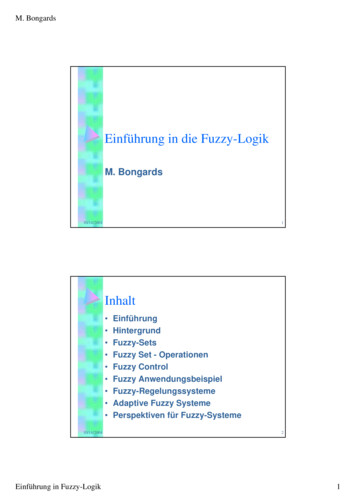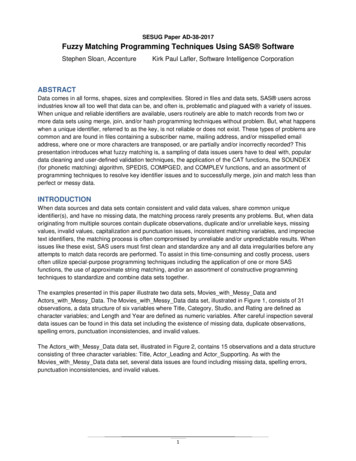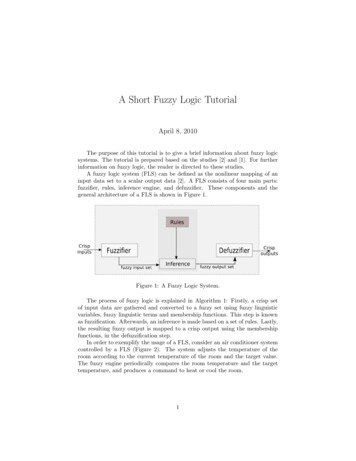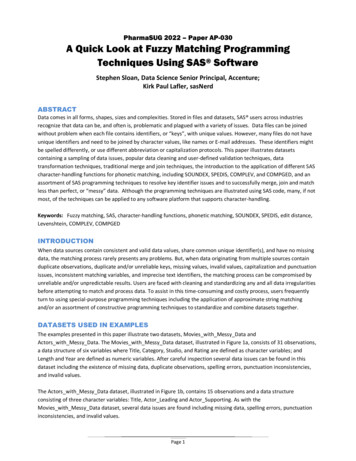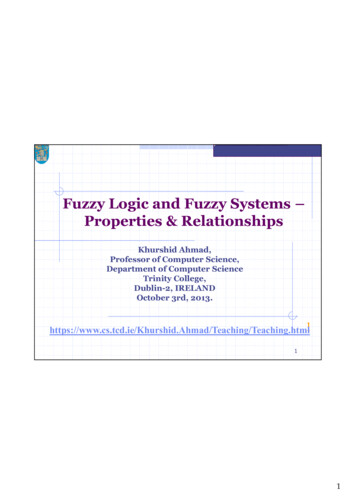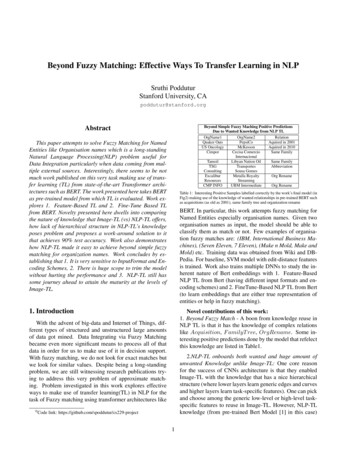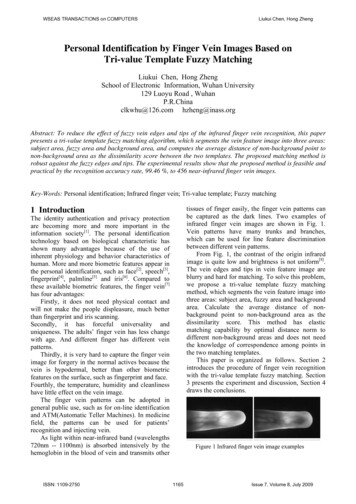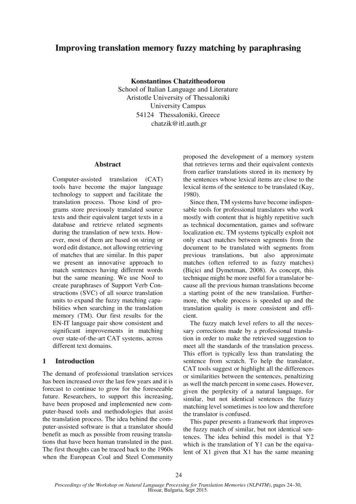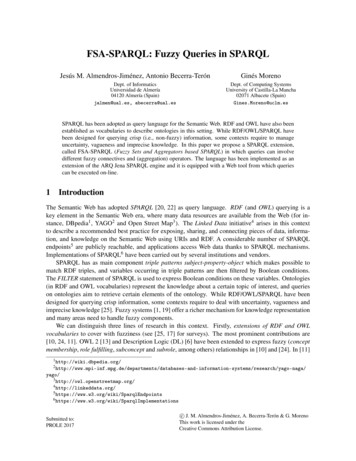
Transcription
Fuzzy Matching Programming TechniquesUsing SAS SoftwareKirk Paul Lafler, Software Intelligence CorporationStephen Sloan, AccentureAbstractData comes in all forms, shapes, sizes and complexities. Stored in files and data sets, SAS users across industriesknow all too well that data can be, and often is, problematic and plagued with a variety of issues. When unique andreliable identifiers are available, users routinely are able to match records from two or more data sets using merge,join, and/or hash programming techniques without problem. But, what happens when a unique identifier, referred toas the key, is not reliable or does not exist. These types of problems are common and are found in files containing asubscriber name, mailing address, and/or misspelled email address, where one or more characters are transposed, orare partially and/or incorrectly recorded? This presentation introduces what fuzzy matching is, a sampling of dataissues users have to deal with, popular data cleaning and user-defined validation techniques, the application of theCAT functions, the SOUNDEX (for phonetic matching) algorithm, SPEDIS, COMPGED, and COMPLEV functions, and anassortment of programming techniques to resolve key identifier issues and to successfully merge, join and match lessthan perfect or messy data.IntroductionWhen data sources and data sets contain consistent and valid data values, share common unique identifier(s), andhave no missing data, the matching process rarely presents any problems. But, when data originating from multiplesources contain duplicate observations, duplicate and/or unreliable keys, missing values, invalid values, capitalizationand punctuation issues, inconsistent matching variables, and imprecise text identifiers, the matching process is oftencompromised by unreliable and/or unpredictable results. When issues like these exist, SAS users must first clean andstandardize any and all data irregularities before any attempts to match data records are performed. To assist in thistime-consuming and costly process, users often utilize special-purpose programming techniques including theapplication of one or more SAS functions, the use of approximate string matching, and/or an assortment ofconstructive programming techniques to standardize and combine data sets together.The examples presented in this paper illustrate two data sets, Movies with Messy Data andActors with Messy Data. The Movies with Messy Data data set, illustrated in Figure 1, consists of 31 observations,a data structure of six variables where Title, Category, Studio, and Rating are defined as character variables; andLength and Year are defined as numeric variables. After careful inspection several data issues can be found in this dataset including the existence of missing data, duplicate observations, spelling errors, punctuation inconsistencies, andinvalid values.The Actors with Messy Data data set, illustrated in Figure 2, contains 15 observations and a data structure consistingof three character variables: Title, Actor Leading and Actor Supporting. As with the Movies with Messy Data dataset, several data issues are found including missing data, spelling errors, punctuation inconsistencies, and invalidvalues.Page 1
Exploring the World of Fuzzy Matching Programming Techniques Using SAS Software, continuedIASUG 2017Figure 2. Actors with Messy Data data set.Figure 1. Movies with Messy Data data set.The Matching Process ExplainedIn an age of endless spreadsheets, apps and relational database management systems (RDBMS), it’s unusual to find asingle sheet, file, table or data set that contains all the data needed to answer an organization’s questions. Today’sdata exists in many forms and all too often involves matching two or more data sources to create a combined file. Thematching process typically involves combining two or more data sets, spreadsheets and/or files possessing a shared,common and reliable, identifier (or key) to create a single data set, spreadsheet and/or file. The matching process,illustrated in the following diagram, shows two tables with a key, Title, to combine the two tables together.MOVIES TitleLengthCategoryYearStudioRatingACTORS TitleActor LeadingActor SupportingBut, when a shared and reliable key is associated with input data sources that are nonexistent, inexact, or unreliable,the matching process often becomes more involved and problematic. As cited in Sloan and Hoicowitz (2016), specialprocesses are needed to successfully match the names and addresses from different files when they are similar, butnot exactly the same. In a constructive and systematic way the authors of this paper describe a six step approach tocleansing data and performing fuzzy matching techniques.Page 2
Exploring the World of Fuzzy Matching Programming Techniques Using SAS Software, continuedIASUG 2017Step 1: Remove extraneous characters.As a general rule, punctuation can differ while the names are the same. For example, John’s “super” pizza and John’ssuper pizza refer to the same restaurant. Therefore, we remove the following characters from all names: ‘ “ & ? - .Step 2: Put all characters in upper-case notation and remove leading blanks.Step 3: Remove words that might or might not appear in the same company name.Some examples are The, .com, Inc, LTD, LLC, DIVISION, CORP, CORPORATION, CO., and COMPANY.Step 4: Rationalize the zip codes when matching addresses.We found it useful to remove the last 4 digits of 9-digit zip codes, because some files might only have 5-digit zip codes.Since some files might have zip codes as numeric fields, and other files might have zip codes as character fields, makesure to include leading zeroes. For example, zip codes with a leading zero, as in 08514, would appear in a numericfield as 8514 requiring the leading zero to be inserted.If working with US zip codes, make sure they are all numeric. This may not apply for other countries. One commonmistake to watch for is that sometimes Canada, with abbreviation CA, is put in as the state CA (California) instead ofthe country CA. Since Canada has an alphanumeric 6-character zip code, this, hopefully, will be caught when checkingfor numeric zip codes.Step 5: Choose a standard for addresses.Decide whether to use Avenue or Ave, Road or Rd, etc, and then convert the address fields to match the standard.Step 6: Match the names and addresses using one or more fuzzy matching techniques.Users have an assortment of powerful SAS algorithms, functions and programming techniques to choose from.Fuzzy matching is the process by which data is combined where a known key either does not exist and/or thevariable(s) representing the key is/are unreliable. In Dunn (2014), the author suggests addressing these types ofscenarios using the following steps.1.2.3.Determine the likely matching variables using metadata (e.g., PROC CONTENTS, etc.) listings.Perform data cleaning.Use the COMPGED function to determine the dissimilarity between two strings.The authors of this paper agree with Sloan & Hoicowitz, and Dunn’s strategies for handling fuzzy matching issues. But,we also want to stress the importance of understanding the physical side of data along with the distribution of datavalues. To address these areas, we suggest adhering to a five step approach, as follows:1.2.3.4.5.Determine the likely matching variables using metadata (e.g., PROC CONTENTS, etc.) listings.Understand the distribution of data values including the number of levels for categorical and key variables.Perform data cleaning.Perform data transformations.Use Fuzzy matching programming techniques when a reliable key between data sources are nonexistent, inexactor unreliable.Page 3
Exploring the World of Fuzzy Matching Programming Techniques Using SAS Software, continuedIASUG 2017Step #1: Determining the Likely Matching VariablesThis first step determines whether any variables exist for matching purposes. Using a PROC CONTENTS alphabetical listof variables and attributes listing for the data sets, Movies with Messy Data and Actors with Messy Data, shownbelow; compare each variable assessing the likelihood of potential matching variables. The PROC CONTENTS code isillustrated below.PROC CONTENTS Code:proc contents data mydata.Movies with Messy Data ;run ;proc contents data mydata.Actors with Messy Data ;run ;From the PROC CONTENTS listing, illustrated in Figure 3, we see that TITLE is consistently defined in both data sets as a 30 character variable. Based on this, we examine the values of the TITLE variable in greater detail to determinewhether it can serve as the key for matching observations in both data sets, as well as the distribution of data valuesfor other categorical variables.Movies with Messy DataActors with Messy DataFigure 3. PROC CONTENTS Metadata Results.Step #2: Understanding the Distribution of Data Values and NLEVELSTo derive a more accurate picture of the data sources, we suggest that users conduct extensive data analysis byidentifying missing values, outliers, invalid values, minimum and maximum values, averages, value ranges, duplicateobservations, distribution of values, and the number of distinct values a categorical variable contains. This importantstep provides an understanding of the data, while leveraging the data cleaning and standardizing activities that will beperformed later. One of the first things data wranglers will want to do is explore the data using the FREQ procedure.PROC FREQ Code:proc freq data mydata.Movies with Messy Data ;tables Title / NOCUM NOPERCENTout Missing Titles(where (Title “”)) ;run ;Page 4
Exploring the World of Fuzzy Matching Programming Techniques Using SAS Software, continuedIASUG 2017Reviewing the FREQ results, we see there are duplicate “key” values and missing values, as shown in Figure 4.Figure 4. PROC FREQ Results show duplicate “key” values and missing values.Determining the number of distinct values a categorical variable has is critical knowledge that all data analysts andwranglers seek an answer to. Acquiring this information helps everyone involved to better understand the number ofdistinct variable levels, the unique values and the number of occurrences for developing data-driven programmingconstructs and elements. The FREQ procedure provides details about the number of levels for each categoricalvariable.PROC FREQ Code:title "NLevels for Variables of Interest in Movies with Messy Data" ;proc freq data mydata.Movies with Messy Data nlevels ;tables Title Rating Category Studio / nopct nocum ;run ;Reviewing the PROC FREQ results, we see the distinct variable levels for each variable: Title, Rating, Category andStudio, as shown in Figure 5.Figure 5. PROC FREQ results show the number of levels for each variable of interest.Page 5
Exploring the World of Fuzzy Matching Programming Techniques Using SAS Software, continuedIASUG 2017Reviewing the PROC FREQ results, an assortment of data consistency, validation and capitalization issues have beenidentified for each variable, as shown in Figure 6.Figure 6. PROC FREQ results depict unique values and the number of occurrences for each variable of interest.Step #3: Performing Data CleaningData cleaning, often referred to as data scrubbing, is the process of identifying and fixing data quality issues includingmissing values, invalid character and numeric values, outlier values, value ranges, duplicate observations, and otheranomalies found in data sets. SAS provides many powerful ways to perform data cleaning tasks. For anyone wanting acomplete guide to the various SAS data cleaning techniques, we highly recommend Cody’s Data Cleaning TechniquesUsing SAS, Third Edition. To illustrate one popular data cleaning technique that users frequently turn to for identifyingand removing duplicate observations, we illustrate the SORT procedure.Exploring PROC SORT to Identify and Remove Duplicate ObservationsA popular approach with users for identifying and removing duplicate observations in a data set is to use PROC SORT.By using the SORT procedure’s three options: DUPOUT , NODUPRECS, and NODUPKEYS, users are better able tocontrol how duplicate observations are identified and removed.Specifying the DUPOUT OptionPROC SORT’s DUPOUT option is often used to identify duplicate observations before actually removing them from adata set. A DUPOUT option, often specified when a data set is too large for visual inspection, can be used with theNODUPKEYS or NODUPRECS options to name a data set that contains duplicate keys or entire observations. In the nextexample, the DUPOUT , OUT and NODUPKEY options are specified to identify duplicate keys.Page 6
Exploring the World of Fuzzy Matching Programming Techniques Using SAS Software, continuedIASUG 2017PROC SORT Code:PROC SORT DATA mydata.Movies with Messy DataDUPOUT Movies Dupout NoDupkeyOUT Movies Sorted Cleaned NoDupkeyNODUPKEY ;BY Title ;RUN ;PROC PRINT DATA work.Movies Dupout NoDupkey NOOBS ;TITLE “Observations Slated for Removal” ;RUN ;PROC PRINT DATA work.Movies Sorted Cleaned NoDupkey NOOBS ;TITLE “Cleaned Movies Data Set” ;RUN ;Results:PROC SORT’s NODUPRECS (or NODUPREC) (or NODUP) option identifies observations with identical values for allcolumns. In the next example, the OUT , DUPOUT and NODUPRECS options are specified.Page 7
Exploring the World of Fuzzy Matching Programming Techniques Using SAS Software, continuedPROC SORT Code:PROC SORT DATA mydata.Movies with Messy DataDUPOUT Movies Dupout NoDupRecsOUT Movies Sorted Cleaned NoDuprecsNODUPRECS ;BY Title ;RUN ;PROC PRINT DATA work.Movies Dupout NoDuprecs NOOBS ;TITLE “Observations Slated for Removal” ;RUN ;PROC PRINT DATA work.Movies Sorted Cleaned NoDuprecs NOOBS ;TITLE “Cleaned Movies Data Set” ;RUN ;Results:Page 8IASUG 2017
Exploring the World of Fuzzy Matching Programming Techniques Using SAS Software, continuedIASUG 2017Note: Although the removal of duplicates using PROC SORT is a popular technique among many SAS users, anelement of care should be given to using this method when processing large data sets. Since sort operations can oftenbe CPU-intensive operations, the authors of this paper recommend comparing PROC SORT to procedures like PROCSUMMARY with the CLASS statement to determine the performance impact of one method versus another.Exploring SAS Functions to Modify DataSAS functions are an essential component of the SAS Base software. Representing a variety of built-in and callableroutines, functions serve as the “work horses” in the SAS software providing users with “ready-to-use” tools designedto ease the burden of writing and testing often lengthy and complex code for a variety of programming tasks. Theadvantage of using SAS functions is evident by their relative ease of use, and their ability to provide a more efficient,robust and scalable approach to simplifying a process or programming task.SAS functions span a number of functional categories, including character, numeric, character string matching, dataconcatenation, truncation, data transformation, search, date and time, arithmetic and trigonometric, hyperbolic, stateand zip code, macro, random number, statistical and probability, financial, SAS file I/O, external files, externalroutines, sort, to name a few. The next example illustrates an old, an alternate, and new way of concatenating stringsand/or variables together. The code, results and analysis appear below.DATA Step and CAT Functions:data null ;length NUM 3. A B C D E 8 BLANK 1 ;A 'The' ;NUM 5 ;B ' Cats' ;C 'in' ;D ' the' ;E 'Hat' ;BLANK ' ' ;* Old way of concatenating with TRIM and LEFT functions and concatenation operator ;OLD trim(left(A)) BLANK trim(left(NUM)) BLANK trim(left(B)) BLANK trim(left(C)) BLANK trim(left(D)) BLANK trim(left(E)) ;* Using the STRIP function and concatenation operator ;STRIP strip(A) BLANK strip(NUM) BLANK strip(B) BLANK strip(C) BLANK strip(D) BLANK strip(E) ;* Using the CAT functions to concatenate character and numeric values together ; CATCATQCATSCATTCATXputrun ; cat (A, NUM, B, C, D, E) ; catq(BLANK, A, NUM, B, C, D, E) ; cats(A, NUM, B, C, D, E) ; catt(A, NUM, B, C, D, E) ; catx(BLANK, A, NUM, B, C, D, E) ;OLD / STRIP / CAT / CATQ / CATS / CATT / CATX / ;Page 9
Exploring the World of Fuzzy Matching Programming Techniques Using SAS Software, continuedIASUG 2017Results:OLD The 5 Cats in the HatSTRIP The 5 Cats in the HatCAT The5 CatsintheCATQ "The" 5 " Cats" "inCATS The5CatsintheHatCATT The5 Catsin theHatCATX The 5 Cats in the HatHat" " the" "Hat"Analysis:In the preceding SAS code, a single numeric variable, NUM, and six character variables: A, B, C, D, E, and BLANK aredefined with their respective values as: NUM 5, A ’The’, B ’ Cats’, C ’in’, D ’ the’, E ’Hat’ and BLANK ’ ‘. The oldestway of concatenating two or more strings or variables together is specified using the TRIM and LEFT functions and theconcatenation operator “ ” in an assignment statement. An alternate approach uses a STRIP function with theconcatenation operator “ ” in an assignment statement to join two or more strings or variables together. Finally, thenewer and more robust concatenation approach uses the CAT family of functions: CAT, CATQ, CATS, CATT, and CATX. CAT, the simplest of concatenation functions, joins two or more strings and/or variables together, end-to-endproducing the same results as with the concatenation (double bar) operator. CATQ is similar to the default features of the CATX function, but the CATQ function adds quotation marks to anyconcatenated string or variable. CATS removes all leading and trailing blanks and concatenates two or more strings and/or variables together. CATT removes trailing blanks and concatenates two or more strings and/or variables together. CATX, perhaps the most robust CAT function, removes leading and trailing blanks and concatenates two or morestrings and/or variables together with a delimiter between each.Validating Data with PROC FORMATProblems with data often necessitate time-consuming validation activities. The strategy is to take the time to becomefamiliar with the data and to discover any problems before expending data analysis and reporting resources. A populartechnique used by many to identify data issues is to use the FORMAT procedure. In the next example, a user-definedformat is created with PROC FORMAT, a DATA step identifies data issues associated with the Category variable, and aPROC PRINT is specified to display the Category variable’s data issues.PROC FORMAT, DATA Step and PROC PRINT Code:PROC FORMAT LIBRARY WORK ;VALUE Category Validation'Action' 'Action Adventure' 'Action Cops & Robber' 'Action Sci-Fi' 'Adventure' 'Comedy' 'Drama' 'Drama Mysteries' 'Action''Action Adventure''Action Cops & Robber''Action Sci-Fi''Adventure''Comedy''Drama''Drama Mysteries'Page 10
Exploring the World of Fuzzy Matching Programming Techniques Using SAS Software, continued'Drama Romance''Drama Suspense''Horror'Other 'Drama Romance''Drama Suspense''Horror''ERROR - Invalid Category';RUN ;DATA Validate Category ;SET mydata.Movies with Messy Data ;Check Category PUT(Category, Category Validation.) ;IF Check Category 'ERROR - Invalid Category' THENDO ;PUT 'Category Error: ' Title ;OUTPUT ;END ;RUN ;PROC PRINT DATA work.Validate CategoryNOOBSN ;TITLE "Validation Report for Movie Category Variable" ;VAR Category Title Rating Length Studio Year ;RUN ;SAS Log:The error messages for the variable, Check Category, are displayed, below.Category Error: Brave HeartCategory Error: TitanicCategory Error: Forrest GumppCategory Error: Christmas VacatiionCategory Error:Results:Page 11IASUG 2017
Exploring the World of Fuzzy Matching Programming Techniques Using SAS Software, continuedIASUG 2017Step #4: Performing Data TransformationsData transformations are frequently performed by SAS users. From converting a data set structure from wide to long,long to wide, observations to variables, variables to observations, and more, SAS users have a number of choicesavailable to them. A popular procedure used to transform selected variables into observations and observations intovariables is the TRANSPOSE procedure. Although PROC TRANSPOSE isn’t designed to print or display output, it is handyfor restructuring data in a data set, and is typically used in preparation for special types of processing such as, arrayprocessing. In its simplest form, data can be transformed with, or without, grouping. In the example, below, anungrouped transformation is performed on only the numeric variables in the data set.PROC TRANSPOSE Code:PROC TRANSPOSE DATA mydata.Movies with Messy DataOUT Movies Transposed ;RUN ;Results:Data can be restructured with PROC TRANSPOSE using a grouping variable. In the next example, the Movies data set isfirst sorted in ascending order by the variable RATING, the sort results written to the Movies Sorted data set, andthen the Movies Sorted data set is transposed using the RATING variable as the by-group variable.PROC TRANSPOSE Code:PROC SORT DATA mydata.Movies with Messy DataOUT Movies Sorted ;BY Rating ; /* BY-Group to Transpose */RUN ;PROC TRANSPOSE DATA work.Movies SortedOUT Movies Transposed ;VAR Title ; /* Variable to Transpose */BY Rating ; /* BY-Group to Transpose */RUN ;PROC PRINT DATA Movies Transposed ;RUN ;Results:Page 12
Exploring the World of Fuzzy Matching Programming Techniques Using SAS Software, continuedIASUG 2017Step #5: Using Fuzzy Matching Programming TechniquesFuzzy matching is an essential programming technique used by organizations every day, particularly when thematching variables between data sets are non-existent or unreliable. Although this type of processing can be moreinvolved than traditional matching processing techniques (e.g., interleaving, match-merging, joining, etc.), SAS usershave a number of powerful functions available to them, including the Soundex (phonetic matching) algorithm, and theSPEDIS, COMPGED and COMPLEV functions, to help make fuzzy matching easier and more effective to use.Exploring the Soundex AlgorithmThe Soundex (phonetic matching) algorithm involves matching files on words that sound alike. As one of the earliestfuzzy matching techniques, Soundex was invented and patented by Margaret K. Odell and Robert C. Russell in 1918and 1922 to help match surnames that sound alike. It is limited to finding phonetic matches and adheres to thefollowing rules when performing a search: Is case insensitive (ignores case);Ignores embedded blanks and punctuations;Is better at finding English-sounding names.Although the Soundex algorithm does a fairly good job with English-sounding names, it often falls-short when dealingwith non-English sounding names. In Foley (1999) the author corroborates this by stating, “The Soundex algorithm isnot infallible since it has been known to miss similar-sounding surnames like Rogers and Rodgers while matchingdissimilar surnames such as Hilbert and Heibronn. “So, how does the Soundex algorithm work? As implemented, SAS determines whether a name (or a variable’scontents) sounds like another by converting each word to a code. The value assigned to the code consists of the firstletter in the word followed by one or more digits. Vowels, A, E, I, O and U, along with H, W, Y, and non-alphabeticalcharacters do not receive a coded value and are ignored; and double letters (e.g., ‘TT’) are assigned a single code valuefor both letters. The codes derived from each word conform to the letters and values found in the table, below.LetterValueB, P, F, VC, S, G, J, K, Q, X, ZD, TLM, NR123456To examine how the movie title, Rocky, is assigned a value of R22, R has a value of 6 but is retained as R, O is ignored,C is assigned a value of 2, K is assigned a value of 2, and Y is ignored. The converted code for “Rocky” is then matchedwith any other name that has the same assigned code. The general syntax of the Soundex algorithm takes the form of:Variable * “character-string”In the next example, the Soundex algorithm is illustrated using the * operator in a simple DATA step WHEREstatement and a PROC SQL WHERE-clause to find similar sounding Movie Titles.Page 13
Exploring the World of Fuzzy Matching Programming Techniques Using SAS Software, continuedIASUG 2017Soundex ( *) Algorithm:DATA Soundex Matches ;SET mydata.Movies with Messy Data ;WHERE Title * “Michael” ;RUN ;PROC PRINT DATA Soundex Matches NOOBS ;TITLE “Soundex Algorithm Matches” ;RUN ;TITLE “Soundex Algorithm Matches” ;PROC SQL ;SELECT *FROM mydata.Movies with Messy DataWHERE Title * “Michael” ;QUIT ;Results:Exploring the SPEDIS FunctionThe SPEDIS, Spelling Distance, function and its two arguments evaluates possible matching scenarios by translating akeyword into a query containing the smallest distance value. Because the SPEDIS function evaluates numerousscenarios, it can experience varying performance issues in comparison to other matching techniques. The SPEDISfunction returns a value of zero when the query and keyword arguments match exactly. Users can also liberalize thematching process by specifying spelling distance values greater than zero (e.g., 10, 20, etc.). The general syntax of theSPEDIS function takes the form of:SPEDIS (query, keyword)In the next example, a simple DATA step with a WHERE statement and a PROC SQL with a WHERE-clause areillustrated to how the SPEDIS function is used to find exact matches for Movie Titles.SPEDIS Function:DATA SPEDIS Matches ;SET mydata.Movies with Messy Data ;WHERE SPEDIS(Title,“Michael”) 0 ;RUN ;PROC PRINT DATA work.SPEDIS MatchesNOOBS ;TITLE “SPEDIS Function Matches” ;RUN ;TITLE “SPEDIS Function Matches” ;PROC SQL ;SELECT *FROM mydata.Movies with Messy DataWHERE SPEDIS(Title,“Michael”) 0 ;QUIT ;Results:Page 14
Exploring the World of Fuzzy Matching Programming Techniques Using SAS Software, continuedIASUG 2017In the next example, a DATA step with a WHERE statement and a PROC SQL with a WHERE-clause are illustrated toshow how the SPEDIS function is used to find spelling variations associated with Movie Titles.SPEDIS Function:DATA SPEDIS Matches ;SET mydata.Movies with Messy Data ;WHERE SPEDIS(Title,“Michael”) LE 20 ;RUN ;PROC PRINT DATA work.SPEDIS MatchesNOOBS ;TITLE “SPEDIS Function Matches” ;RUN ;TITLE “SPEDIS Function Matches” ;PROC SQL ;SELECT *FROM mydata.Movies with Messy DataWHERE SPEDIS(Title,“Michael”) LE 20 ;QUIT ;Results:Exploring the COMPGED FunctionThe COMPGED function is another fuzzy matching technique used by the SAS user community. It works by computingand using a Generalized Edit Distance (GED) score when comparing two text strings. In Teres (2011), the authordescribes the Generalized Edit Distance score as “a generalization of the Levenshtein edit distance, which is a measureof dissimilarity between two strings.” Sloan and Hoicowitz describe their experience using the COMPGED function tomatch data sets with unreliable identifiers (or keys) by pointing out, “The higher the GED score the less likely the twostrings match.” Conversely, for the greatest likelihood of a match with the COMPGED function users should seek thelowest derived score from evaluating all the possible ways of matching string-1 with string-2.The COMPGED function returns values that are multiples of 10, e.g., 20, 100, 200, etc. In Cadieux and Bretheim’s(2014) paper, the authors mention that most COMPGED scores of 100 or less are valid matches. So how is theCOMPGED function used to compare two text strings for possible matching? The general syntax of the COMPGEDfunction takes the form of:COMPGED ( string-1, string-2 , cutoff-value , modifier )Required Arguments:string-1 specifies a character variable, constant or expression.string-2 specifies a character variable, constant or expression.Optional Arguments:cutoff-value specifies a numeric variable, constant or expression. If the actual generalized edit distance isgreater than the value of cutoff, the value that is returned is equal to the value of cutoff.modifier specifies a value that alters the action of the COMPGED function. Valid modifier values are:Page 15
Exploring the World of Fuzzy Matching Programming Techniques Using SAS Software, continuedi or Il or Ln or N: (colon) IASUG 2017Ignores the case in string-1 and string-2.Removes leading blanks before comparing the values in string-1 or string-2.Ignores quotation marks around string-1 or string-2.Truncates the longer of string-1 or string-2 to the length of the shorter string.In this first example, a PROC SQL inner join is constructed along with the specification of a COMPGED function to allowfor matches that are not perfect. The COMPGED function derives a value corresponding to the computed generalizededit distance (GED) score as, COMPGED Score in the new table, Movies Fuzzy Matches. As illustrated in the results,the COMPGED Score column contains a subsetted value between 0 and 100 due to the “cutoff-value” of 100 as isspecified in the WHERE-clause expression. Along with the “cutoff-value, the WHERE-clause also eliminates missingtitles from further consideration.PROC SQL Join with COMPGED Function:proc sql noprint ;create table Movies Fuzzy Matches asselect M.Title,Rating,Category,Actor Leading,Actor Supporting,COMPGED(M.Title,A.Title) AS COMPGED Scorefrom mydata.Movies with Messy Data M,mydata.Actors with Messy Data Awhere M.Title NE "" ANDCALCULATED COMPGED Score LE 100order by M.Title ;quit ;Results:Page 16
Exploring the World of Fuzzy Matching Programming Techniques Using SAS Software, continuedIASUG 2017In the next example, the “cutoff-value” is maintained at 100, as it was in the previous example. In addition to theCOMPGED function, a modifier value of “I” has been specified to tell SAS to ignore the case of both string-1 and string2. Unlike the previous example’s results, the results for this example show that the row associated with
Step 6: Match the names and addresses using one or more fuzzy matching techniques. Users have an assortment of powerful SAS algorithms, functions and programming techniques to choose from. Fuzzy matching is the process by which data is combined where a known key either does not exist and/or the variable(s) representing the key is/are unreliable.
